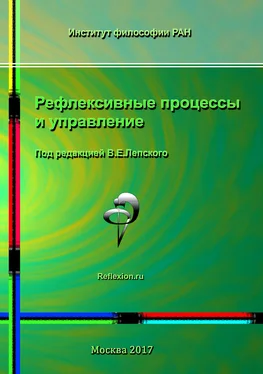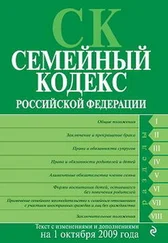The backdraft of implementing BDA is, that it cannot imply all of the knowledge on complex issues, especially if the data quality or the number of cases recorded is not sufficient to provide reliable models. Therefore Big Data stored knowledge should be focussed on supporting processes, related to relatively simple instances, with multiple repetitions.
3.4 The mechanisms to manage the representation of the complexity are redefined. The main goal of an organisation is to coordinate individual capabilities to achieve itsindividually defined goals. The knowledge of an organisation is a complex combination of structured rules and shared tacit knowledge on multiple levels, gained from previous experiences – gained through previous activities or acquired from the environment.
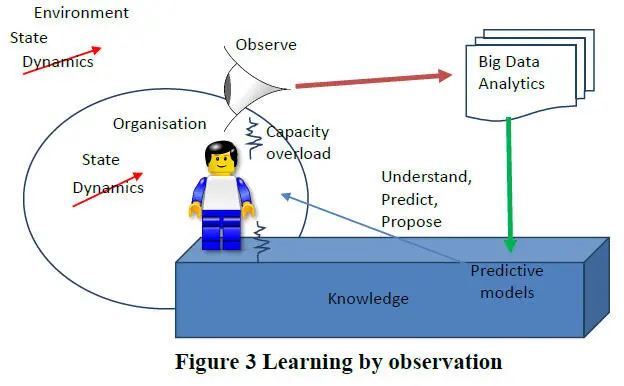
Figure 3. Learning by observation
BDA tools use a different approach than Business intelligence. Instead of reducing variety and focusing solely on financial business outcomes, they provide the option to understand, predict or even propose activities on the detailed data, provided by the organisation.
3.5 The inter and trans team learning and experience sharing is redefined.
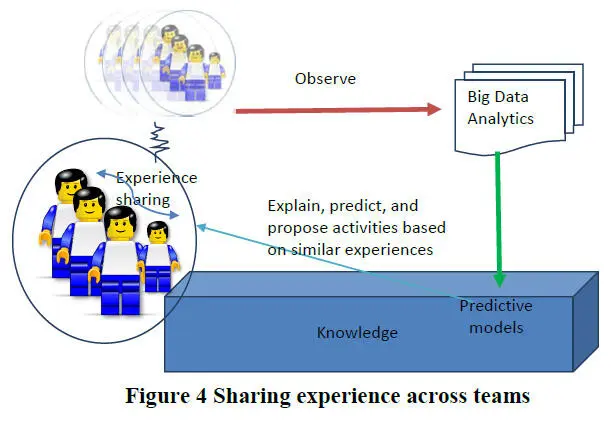
Figure 4. Sharing experience across teams
The experiences of multiple teams in similar situations can be successfully identified, understood, and learned upon with the help of BDA. For example, the effects of using multiple communication marketing campaigns in multiple markets can be compared.
There is though a limitation of using BDA to support learning between the teams. It works well in a highly repetitive processes, where data on similar situations are easily obtainable, as for instance sales, or mass production. If there are not enough similar cases, or if the data variety to explain a cases is too high, BDA cannot adequately provide insight.
3.6 BDA support the interhierarchical learning processes and reduce the number of the hierarchical recursion levels.
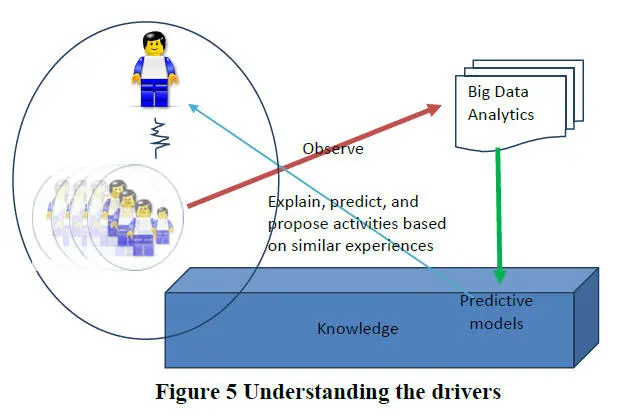
Figure 5. Understanding the drivers
The BDA is used by the higher levels in two ways: First, by elaborating the feedbacks of the lower structural recursion levels, it can fine-tune the activities, guiding to the desired results. Secondly, it can use BDA to better understand the needs, processes and relations at lower levels to propose solutions that provide value added for all the subjects, affected by the organizations. The higher capacity to manage variety also reduces the need for hierarchy and allows structural recursion. In some cases, the automated guiding systems can entirely eliminate the need for intermediaries between the consumer and provider on a global scale.
References
1. Addo-Tenkorang, R., & Helo, P. T. (2016). Big data applications in operations/supply-chain management: A literature review. [Review]. Computers & Industrial Engineering, 101, 528–543. doi: 10.1016/j.cie.2016.09.023.
2. Akter, S., Wamba, S. F., Gunasekaran, A., Dubey, R., & Childe, S. J. (2016). How to improve firm performance using big data analytics capability and business strategy alignment? [Article]. International Journal of Production Economics, 182, 113–131. doi: 10.1016/j.ijpe.2016.08.018.
3. Argote, L., & Miron-Spektor, E. (2011). Organizational Learning: From Experience to Knowledge. [Article]. Organization Science, 22(5), 1123–1137. doi: 10.1287/orsc.1100.0621.
4. Ashby, W. R. (1964). An Introduction to Cybernetics. London: Methuen & Co Ltd.
5. Beer, S. (1979). The Heart of Enterprise. Chichester: Willey.
6. Beer, S. (1981). Brain of the Firm (2nd ed.). Chichester: Wiley.
7. Beer, S. (1985). Diagnosing the system for organisation. Chrichester: John Wiley.
8. Bello-Orgaz, G., Jung, J. J., & Camacho, D. (2016). Social big data: Recent achievements and new challenges. [Article]. Information Fusion, 28, 45–59. doi: 10.1016/j.inffus.2015.08.005
9. Bellomo, N., Clarke, D., Gibelli, L., Townsend, P., & Vreugdenhil, B. J. (2016). Human behaviours in evacuation crowd dynamics: From modelling to "big data" toward crisis management. [Review]. Physics of Life Reviews, 18, 1-21. doi: 10.1016/j.plrev.2016.05.014
10. Conant, R., & Ashby, W. R. (1970). Every good regulator of a system must be a model of that system. Intern. J. of Systems Science 1(2), 89–97.
11. Espejo, R. (1993). Management of Complexity in Problem Solving. In R. Espejo & M. Schwaninger (Eds.), Organizational Fitness: Corporate Effectiveness through management cybernetics (pp. 67–90). Frankfurt and New York: Campus Verlag.
12. Espejo, R., Bowling, D., & Hoverstadt, P. (1999). The viable system model and the Viplan software. [Article]. Kybernetes, 28(6–7), 661–678. doi: 10.1108/03684929910282944
13. Espejo, R., & Reyes, A. (2011). Organizational Systems: Managing Complexity with the Viable System Model. Heidelberg: Springer.
14. Espejo, R., Schuhmann, M., Schwaninger, M., & Bilello, H. (1996). Organizational Transformation and Learning. Chichester: Wiley.
15. Gupta, M., & George, J. F. (2016). Toward the development of a big data analytics capability. [Article]. Information & Management, 53(8), 1049–1064. doi: 10.1016/j.im.2016.07.004
16. Hashem, I. A. T., Yaqoob, I., Anuar, N. B., Mokhtar, S., Gani, A., & Khan, S. U. (2015). The rise of "big data" on cloud computing: Review and open research issues. [Article]. Information Systems, 47, 98-115. doi: 10.1016/j.is.2014.07.006
17. Kimball, R. (2002). The Data Warehouse Toolkit: The Complete Guide to Dimensional Modeling: Wiley.
18. Koskinen, K. U. (2012). Problem absorption as an organizational learning mechanism in project-based companies: Process thinking perspective. [Article]. International Journal of Project Management, 30(3), 308–316. doi: 10.1016/j.ijproman.2011.08.008
19. Maturana, H., & Varela, F. (1992). The Tree of Knowledge. Boston and London: Shambhala.
20. McAfee, A., & Brynjolfsson, E. (2012). STRATEGY & COMPETITION Big Data: The Management Revolution. [Article]. Harvard Business Review, 90(10), 60-+.
21. Perko. (2017). Behaviour-based short-term invoice probability of default evaluation. [Article]. European Journal of Operational Research, 257(3), 1045–1054. doi: 10.1016/j.ejor.2016.08.039
22. Perko, & Ototsky, P. (2016). Big Data for Business Ecosystem Players. 62(2), 12–24.
23. Perko, Primec, A., & Horvat, R. (2015). Sharing business partner behavior. [Article]. Kybernetes, 44(6–7), 1030–1048. doi: 10.1108/k-12-2014-0282.
24. Sivarajah, U., Kamal, M. M., Irani, Z., & Weerakkody, V. (2017). Critical analysis of Big Data challenges and analytical methods. [Article]. Journal of Business Research, 70, 263–286. doi: 10.1016/j.jbusres.2016.08.001
25. Wamba, S. F., Gunasekaran, A., Akter, S., Ren, S. J. F., Dubey, R., & Childe, S. J. (2017). Big data analytics and firm performance: Effects of dynamic capabilities. [Article]. Journal of Business Research, 70, 356–365. doi: 10.1016/j.jbusres.2016.08.009.
Thomas Fischer (American Society for Cybernetics)
Cybernetic reentry: towards a reflexive pedagogy for cybernetics
Abstract. As a way of conceptualizing and of pursuing epistemological practices, such as learning, designing and researching, cybernetics should enjoy a front row position within academic settings today. However, being aligned orthogonally to – and occasionally challenging – the utilitarianism, revenue models, reward-orientation, and control structures of many academic and research organizations, cybernetics as an academic discipline is in serious crisis. In many parts of the world, it no longer enjoys the levels of funding support, student numbers, academic workforce and opportunities to offer study programs it enjoyed a few decades ago. While many cybernetic ideas and theories have been absorbed by other fields, where they are pursued in specialist engineering approaches, the study of cybernetics as a generalist philosophy has all but disappeared from formal curricula in many parts of the world. Furthermore, in many parts of the word the more generalist subject of cybernetics and its more specialist sister subject of computing have drifted apart, resulting in a disciplinary as well as philosophical fragmentation of the field.
Читать дальше
